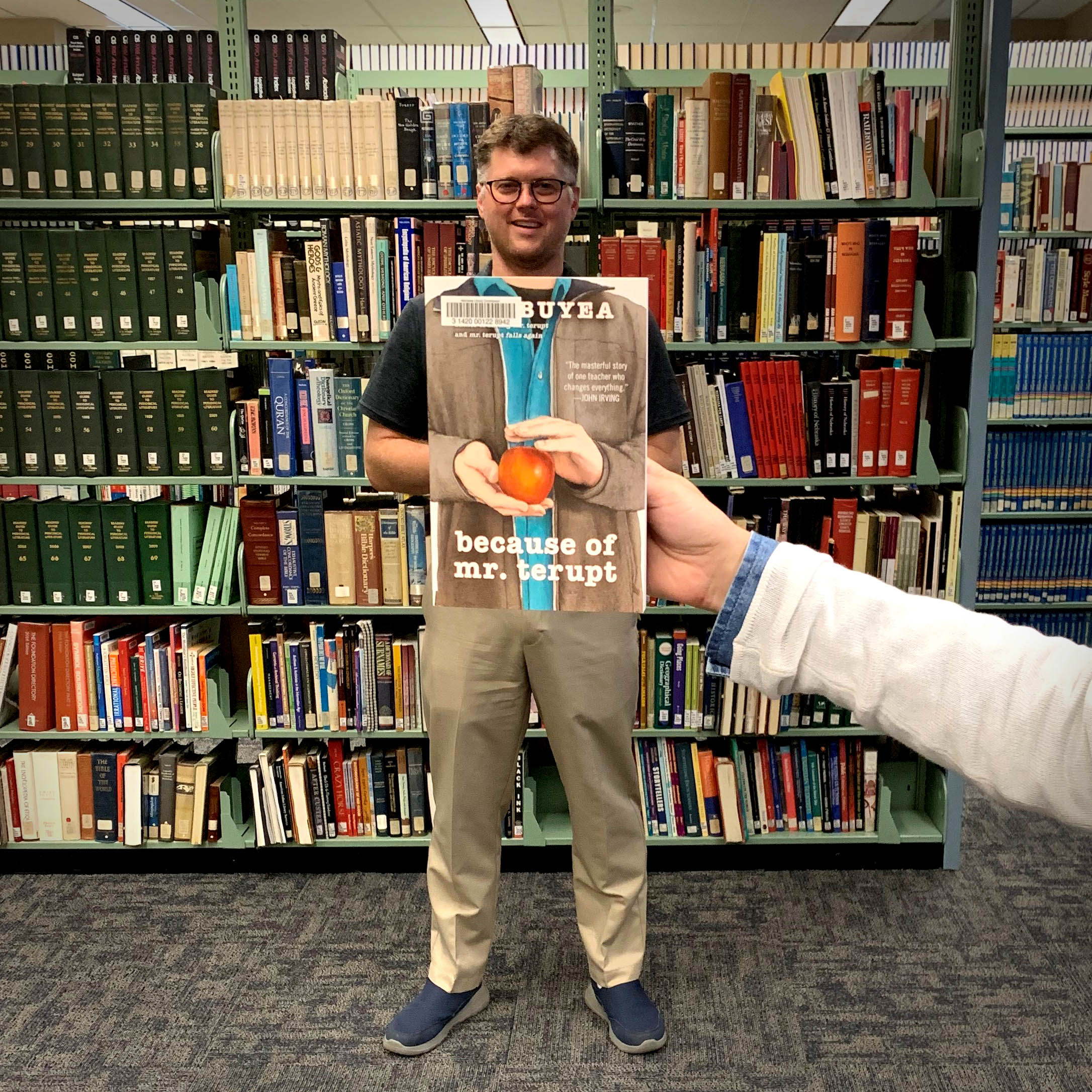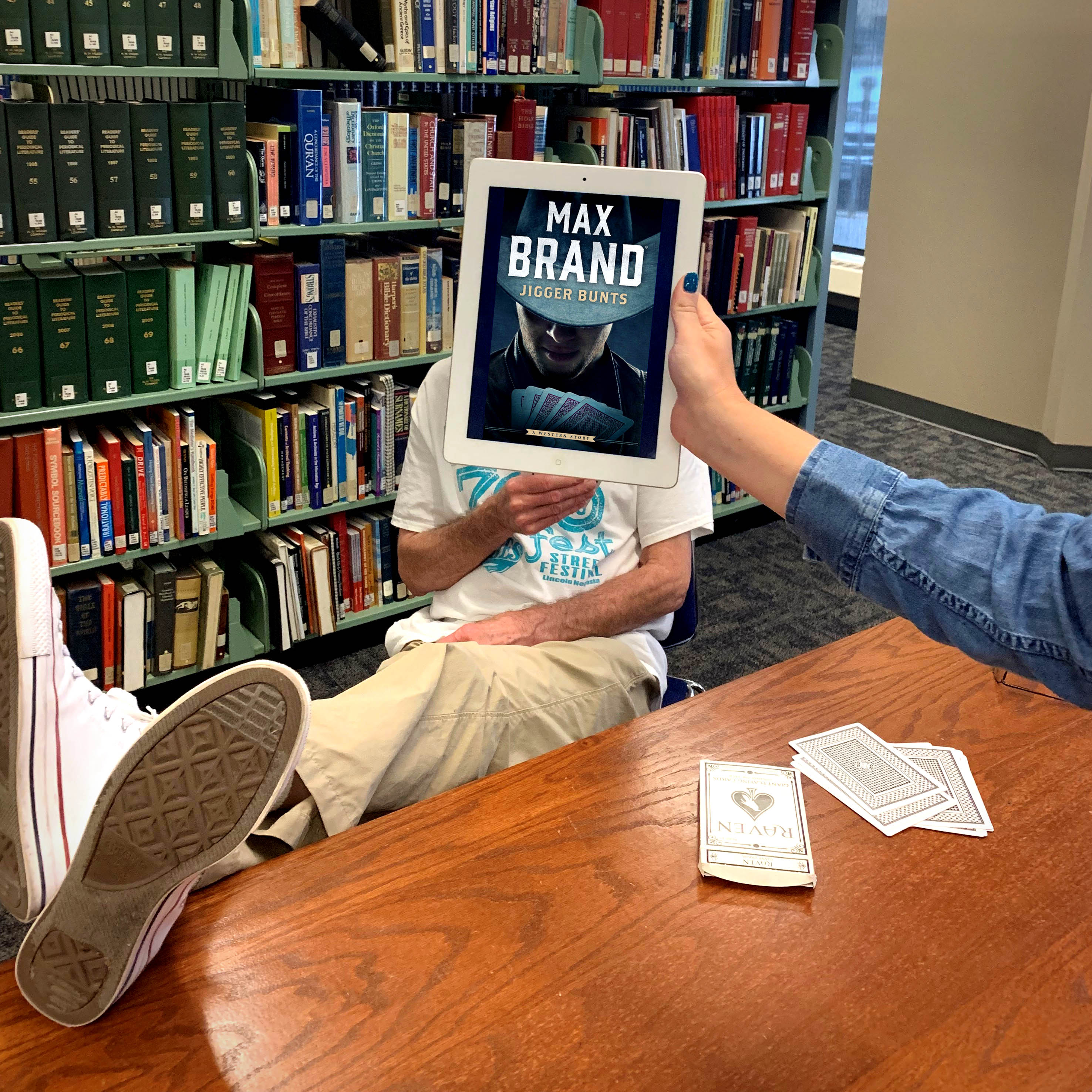Search the Blog
Categories
- Books & Reading
- Broadband Buzz
- Census
- Education & Training
- Friday Reads
- General
- Grants
- Information Resources
- Library Management
- Nebraska Center for the Book
- Nebraska Libraries on the Web
- Nebraska Memories
- Now hiring @ your library
- Preservation
- Pretty Sweet Tech
- Programming
- Public Library Boards of Trustees
- Public Relations
- Talking Book & Braille Service (TBBS)
- Technology
- Uncategorized
- What's Up Doc / Govdocs
- Youth Services
Archives
Subscribe
Category Archives: General
2020 Census : Four Ways to Respond
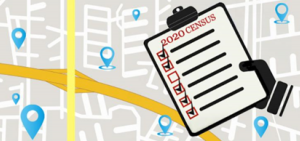 There are changes to the 2020 Census that will make it easier than ever for everyone to respond. The information bulletin below gives the 4 ways people can answer the Census questions, and can be printed out as a handout or a poster.
There are changes to the 2020 Census that will make it easier than ever for everyone to respond. The information bulletin below gives the 4 ways people can answer the Census questions, and can be printed out as a handout or a poster.
2020 Census : Counting Young Children, What You Need to Know
 The 2020 Census: Counting everyone once, only once, and in the right place.
The 2020 Census: Counting everyone once, only once, and in the right place.
An estimated 5% of kids under the age of 5 weren’t counted in the 2010 Census. That’s about 1 million young children, the highest of any age group. We need your help closing this gap in the 2020 Census. The information bulletin below tells us what research has discovered about why young children are missed and what you can do to help make sure they are counted. The information bulletin can be printed out as a handout, or as a poster:
Census 101 : What You Need to Know, in English and Spanish
 The 2020 Census is closer than you think! Here’s a quick refresher of what it is and why it’s essential everyone is counted.
The 2020 Census is closer than you think! Here’s a quick refresher of what it is and why it’s essential everyone is counted.
¡El censo del 2020 está más cerca de lo que piensas! A continuación te damos un
rápido repaso de lo que es y por qué es esencial que todos seamos contados
The information page below can be printed out as a handout or a poster:
Economic Census : What’s New For 2017 Data
The published data from the 2017 Economic Census will reflect many changes from the data that was published in the 2012 Economic Census. These changes mirror the ever-changing U.S. economy, communities, and data user needs. Below is a summary of these key changes and links to more information.
For a list of the data products for the 2017 Economic Census, see the high-level release schedule at: https://www.census.gov/programs-surveys/economic-census/about/release-schedules.html
Geographic Areas
The 2017 Economic Census will publish data to reflect the ever changing geographic areas as of January 2017. Reference materials that highlight the changes from the 2012 Economic Census will be provided on this site, including maps and documents that highlight the changes to:
- Metro Areas – the Core Based Statistical Areas in 15 states had some type of change
- Counties – Alaska, South Dakota, and Virginia had changes to 1 or more counties
- Economic Places – every state had places with area gain, loss, and/or code or name changes. There are 442 new Economic Places being recognized and 171 places that are being dropped for 2017, primarily due to population decline
NAICS
The 2017 Economic Census will be the first Census program to publish data on the 2017 North American Industry Classification System. 6 of the 18 sectors covered by the Economic Census will see changes to the codes published. These changes include:
- One-to-one recodes – industries with no content change but with a code change
- Many-to-one combinations – 2012 NAICS codes that were combined to form a new 2017 code
- Many-to-many combinations – 2 or more 2017 codes that were created from parts of 2 or more 2012 codes
NAPCS
A key offering from the Economic Census are the detailed Product Lines data, which provides a more detailed breakout of the products made and sold and services provided by businesses. These data from the 2012 Economic Census were provided in separate data tables by sector that provided different information. For the 2017 Economic Census, these data are being consolidated and reformatted following the new North American Product Classification System.
Other Changes
The data products from the 2017 Economic Census will include a number of structural and content changes. These include:
- The new “First Look” report – this new report will feature data not available in the initial “Advance Report” release in prior Economic Censuses.
- Consolidated “Size” reports – These data tables which provide detailed breakouts based on the employment and sales/revenue size of establishments or firms were published in separate and disparate tables by sector. For 2017, these tables are being consolidated and standardized across sectors.
- Added and dropped Miscellaneous Subjects reports – 38 tables from the 2012 Economic Census are being dropped, and 7 new tables are being added. Also, the tables showing data by Class of Customer, Enterprise Support, and Exported Services are similarly being consolidated.
- New disclosure rules – In prior Economic Censuses, the number of establishments was published even when the other statistics for an industry and geography were withheld due to disclosure. For 2017, new privacy rules will result in the establishment count being suppressed when less than 3 or when the other statistics are suppressed.
- Local areas published by sector – Place-level data will no longer be available for the Manufacturing sector and the NAICS and geographic levels published for other sectors may be adjusted based on data quality and privacy issues.
- New data.census.gov platform – the data tables from the 2017 Economic Census will be published on this new dissemination platform. Historical data from the 2012 Economic Census will continue to be available on American FactFinder under they are migrated to the new platform.
What’s Up Doc? New State Agency Publications at the Nebraska Library Commission
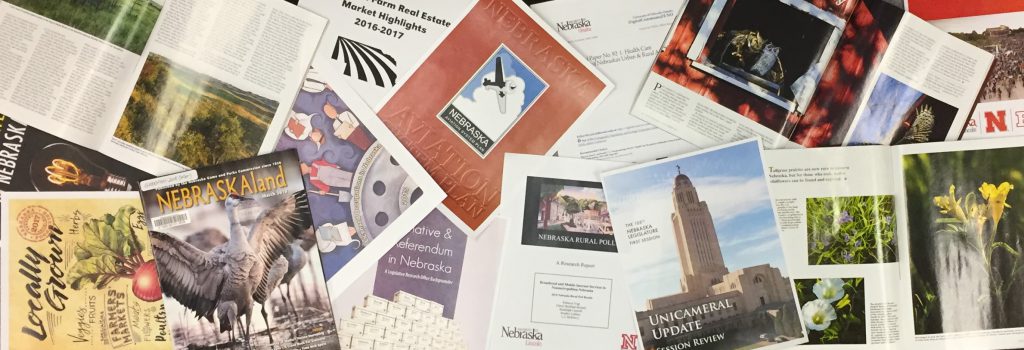 New state agency publications have been received at the Nebraska Library Commission for July 2019. Included are Urban Research Reports from the Center for Applied Urban Research at University of Nebraska–Omaha, reports from the Nebraska Department of Health and Human Services, Legal Aid of Nebraska, Nebraska Department of Natural Resources, and new books from the University of Nebraska Press, to name a few.
New state agency publications have been received at the Nebraska Library Commission for July 2019. Included are Urban Research Reports from the Center for Applied Urban Research at University of Nebraska–Omaha, reports from the Nebraska Department of Health and Human Services, Legal Aid of Nebraska, Nebraska Department of Natural Resources, and new books from the University of Nebraska Press, to name a few.
Most items, except the books from the University of Nebraska Press, are available for immediate viewing and printing by clicking on the highlighted link above, or directly in the .pdf below. You can read synopses of the books received from the University of Nebraska Press books in the July blogpost.
The Nebraska Legislature created the Nebraska Publications Clearinghouse in 1972, a service of the Nebraska Library Commission. Its purpose is to collect, preserve, and provide access to all public information published by Nebraska state agencies. By law (State Statutes 51-411 to 51-413) all Nebraska state agencies are required to submit their published documents to the Clearinghouse. For more information, visit the Nebraska Publications Clearinghouse page, contact Mary Sauers, Government Information Services Librarian; or contact Bonnie Henzel, State Documents Staff Assistant.
#BookFaceFriday “Because of Mr. Terupt”
This #BookFace is going back to school, back to school!
…to prove to dad I’m not a fool. Just kidding, #BookFaceFriday never has to prove that. As all the kids, teachers, families, and librarians gear up for another year, we’ve got a great start to your youth book clubs! Check out “Because of Mr. Terupt” by Rob Buyea (Yearling, 2011). Written from the perspective of seven fifth graders, this children’s chapter book has a character that every type of kid can relate to. As a part of our NLC Book Club Kit collection, this read would be a great start to any school year.
“The characters are authentic and the short chapters are skillfully arranged to keep readers moving headlong toward the satisfying conclusion.”–School Library Journal
This week’s #BookFaceFriday model is Gabe Kramer, our new Director of Talking Book & Braille Services. Learn all about him in his recent NLC Staff profile!
Love this #BookFace & reading? Check out our past #BookFaceFriday photos on the Nebraska Library Commission’s Facebook page!
Posted in Books & Reading, General
Tagged back to school, Because of Mr. Terupt, Book Club Kits, Book Covers, bookface, bookfacefriday, Kids, Reading, Rob Buyea
Leave a comment
Throwback Thursday
School is right around the corner!
As students across the state get ready for the new school year, we thought this throwback to 1970 would be perfect for this week’s #ThrowbackThursday!
This 10″ x 8″ black and white photograph comes from the Nebraska Wesleyan University, Cochrane-Woods Library collection on the Nebraska Memories archive. The collection consists of mainly exterior shots of individual buildings, along with several views of the campus layout as it evolved from 1891 through the 1970s.
Interested in Nebraska history? Check out the Nebraska Memories archive.
Nebraska Memories is a cooperative project to digitize Nebraska-related historical and cultural heritage materials and make them available to researchers of all ages via the Internet. The Nebraska Memories archive is brought to you by the Nebraska Library Commission. If your institution is interested in participating in Nebraska Memories, see http://nlc.nebraska.gov/nebraskamemories/participation.aspx for more information.
Book Briefs: New University of Nebraska Press Books at the Nebraska Publications Clearinghouse
 The Nebraska Publications Clearinghouse receives documents every month from all Nebraska state agencies, including the University of Nebraska Press (UNP). Each month we will be showcasing the UNP books that the Clearinghouse receives. UNP books, as well as all Nebraska state documents, are available for checkout by libraries and librarians, for their patrons, in Nebraska.
The Nebraska Publications Clearinghouse receives documents every month from all Nebraska state agencies, including the University of Nebraska Press (UNP). Each month we will be showcasing the UNP books that the Clearinghouse receives. UNP books, as well as all Nebraska state documents, are available for checkout by libraries and librarians, for their patrons, in Nebraska.
Here are the UNP books the Clearinghouse received in July:
 Art from Trauma : Genocide and Healing Beyond Rwanda Edited and with an introduction by Rangira Bea Gallimore and Gerise Herndon
Art from Trauma : Genocide and Healing Beyond Rwanda Edited and with an introduction by Rangira Bea Gallimore and Gerise Herndon
What is the role of aesthetic expression in responding to discrimination, tragedy, violence, even genocide? How does gender shape responses to both literal and structural violence, including implicit linguistic, familial, and cultural violence? How might writing or other works of art contribute to healing? Art from Trauma: Genocide and Healing beyond Rwanda explores the possibility of art as therapeutic, capable of implementation by mental health practitioners crafting mental health policy in Rwanda.
This anthology of scholarly, personal, and hybrid essays was inspired by scholar and activist Chantal Kalisa (1965–2015). At the commemoration of the nineteenth anniversary of the genocide in Rwanda, organized by the Rwandan Embassy in Washington DC, Kalisa gave a presentation, “Who Speaks for the Survivors of the Genocide against Tutsi?” Kalisa devoted her energy to giving expression to those whose voices had been distorted or silenced. The essays in this anthology address how the production and experience of visual, dramatic, cinematic, and musical arts, in addition to literary arts, contribute to healing from the trauma of mass violence, offering preliminary responses to questions like Kalisa’s and honoring her by continuing the dialogue in which she participated with such passion, sharing the work of scholars and colleagues in genocide studies, gender studies, and francophone literatures.
Give the Word : Responses to Werner Hamacher’s 95 Theses on Philology Edited by Gerhard Richter and Ann Smock (Series: Stages)
Edited by Gerhard Richter and Ann Smock (Series: Stages)
Werner Hamacher’s witty and elliptical 95 Theses on Philology challenges the humanities—and particularly academic philology—that assume language to be a given entity rather than an event. In Give the Word eleven scholars of literature and philosophy (Susan Bernstein, Michèle Cohen-Halimi, Peter Fenves, Sean Gurd, Daniel Heller-Roazen, Jan Plug, Gerhard Richter, Avital Ronell, Thomas Schestag, Ann Smock, and Vincent van Gerven Oei) take up the challenge presented by Hamacher’s theses. At the close Hamacher responds to them in a spirited text that elaborates on the context of his 95 Theses and its rich theoretical and philosophical ramifications.
The 95 Theses, included in this volume, makes this collection a rich resource for the study and practice of “radical philology.” Hamacher’s philology interrupts and transforms, parting with tradition precisely in order to remain faithful to its radical but increasingly occluded core.
The contributors test Hamacher’s break with philology in a variety of ways, attempting a philological practice that does not take language as an object of knowledge, study, or even love. Thus, in responding to Hamacher’s Theses, the authors approach language that, because it can never be an object of any kind, awakens an unfamiliar desire. Taken together these essays problematize philological ontology in a movement toward radical reconceptualizations of labor, action, and historical time.
 Life of the Indigenous Mind : Vine Deloria Jr. and the Birth of the Red Power Movement David Martinez (Series: New Visions in Native American and Indigenous Studies)
Life of the Indigenous Mind : Vine Deloria Jr. and the Birth of the Red Power Movement David Martinez (Series: New Visions in Native American and Indigenous Studies)
In Life of the Indigenous Mind David Martínez examines the early activism, life, and writings of Vine Deloria Jr. (1933–2005), the most influential indigenous activist and writer of the twentieth century and one of the intellectual architects of the Red Power movement. An experienced activist, administrator, and political analyst, Deloria was motivated to activism and writing by his work as executive director of the National Congress of American Indians, and he came to view discourse on tribal self-determination as the most important objective for making a viable future for tribes.
In this work of both intellectual and activist history, Martínez assesses the early life and legacy of Deloria’s “Red Power Tetralogy,” his most powerful and polemical works: Custer Died for Your Sins (1969), We Talk, You Listen (1970), God Is Red (1973), and Behind the Trail of Broken Treaties (1974). Deloria’s gift for combining sharp political analysis with a cutting sense of humor rattled his adversaries as much as it delighted his growing readership.
Life of the Indigenous Mind reveals how Deloria’s writings addressed Indians and non-Indians alike. It was in the spirit of protest that Deloria famously and infamously confronted the tenets of Christianity, the policies of the Bureau of Indian Affairs, and the theories of anthropology. The concept of tribal self-determination that he initiated both overturned the presumptions of the dominant society, including various “Indian experts,” and asserted that tribes were entitled to the rights of independent sovereign nations in their relationship with the United States, be it legally, politically, culturally, historically, or religiously.
Messianic Fulfillments : Staging Indigenous Salvation in America Hayes Peter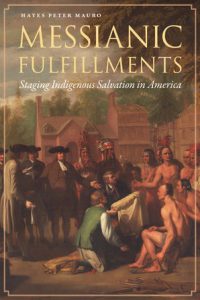 Mauro
Mauro
In Messianic Fulfillments Hayes Peter Mauro examines the role of Christian evangelical movements in shaping American identity in the seventeenth, eighteenth, and nineteenth centuries. Focusing on Christianity’s fervent pursuit of Native American salvation, Mauro discusses Anglo American artists influenced by Christian millenarianism, natural history, and racial science in America. Artists on the colonial, antebellum, and post–Civil War frontier graphically projected their idealization of Christian-based identity onto the bodies of American Indians.
Messianic Fulfillments explores how Puritans, Quakers, Mormons, and members of other Christian millenarian movements viewed Native peoples as childlike, primitive, and in desperate need of Christianization lest they fall into perpetual sin and oblivion and slip into eternal damnation. Christian missionaries were driven by the idea that catastrophic Native American spiritual failure would, in Christ’s eyes, reflect on the shortcomings of those Christians tasked with doing the work of Christian “charity” in the New World.
With an interdisciplinary approach drawing from religious studies and the histories of popular science and art, Messianic Fulfillmentsexplores ethnohistorical encounters in colonial and nineteenth-century America through the lens of artistic works by evangelically inspired Anglo American artists and photographers. Mauro takes a critical look at a variety of visual mediums to illustrate how evangelical imagery influenced definitions of “Americaness,” and how such images reinforced or challenged historically prevailing conceptions of what it means (and looks like) to be American.
 National Races : Transnational Power Struggles in the Sciences and Politics of Human Diversity, 1840-1945 Edited by Richard McMahon (Series: Critical Studies in the History of Anthropology)
National Races : Transnational Power Struggles in the Sciences and Politics of Human Diversity, 1840-1945 Edited by Richard McMahon (Series: Critical Studies in the History of Anthropology)
National Races explores how politics interacted with transnational science in the nineteenth and early twentieth centuries. This interaction produced powerful, racialized national identity discourses whose influence continues to resonate in today’s culture and politics. Ethnologists, anthropologists, and raciologists compared modern physical types with ancient skeletal finds to unearth the deep prehistoric past and true nature of nations. These scientists understood certain physical types to be what Richard McMahon calls “national races,” or the ageless biological essences of nations.
Contributors to this volume address a central tension in anthropological race classification. On one hand, classifiers were nationalists who explicitly or implicitly used race narratives to promote political agendas. Their accounts of prehistoric geopolitics treated “national races” as the proxies of nations in order to legitimize present-day geopolitical positions. On the other hand, the transnational community of race scholars resisted the centrifugal forces of nationalism. Their interdisciplinary project was a vital episode in the development of the social sciences, using biological race classification to explain the history, geography, relationships, and psychologies of nations.
National Races goes to the heart of tensions between nationalism and transnationalism, politics and science, by examining transnational science from the perspective of its peripheries. Contributors to the book supplement the traditional focus of historians on France, Britain, and Germany, with myriad case studies and examples of nineteenth- and early twentieth-century racial and national identities in countries such as Russia, Italy, Poland, Greece, and Yugoslavia, and among Jewish anthropologists.
Place and Postcolonial Ecofeminism : Pakistani Women’s Literary and  Cinematic Fictions Shazia Rahman (Series: Expanding Frontiers : Interdisciplinary Approaches to Studies of Women, Gender, and Sexuality)
Cinematic Fictions Shazia Rahman (Series: Expanding Frontiers : Interdisciplinary Approaches to Studies of Women, Gender, and Sexuality)
While news reports about Pakistan tend to cover Taliban attacks and bombings, and academics focus on security issues, the environment often takes a backseat in media reportage and scholarship. In particular, Pakistani women’s attachment to their environment and their environmental concerns are almost always ignored. Shazia Rahman traces the ways in which Pakistani women explore alternative, environmental modes of belonging, examines the vitality of place-based identities within Pakistani culture, and thereby contributes to evolving understandings of Pakistani women—in relation to both their environment and to various discourses of nation and patriarchy.
Through an astute analysis of such works as Sabiha Sumar’s Khamosh Pani (2003), Mehreen Jabbar’s Ramchand Pakistani (2008), Sorayya Khan’s Noor (2006), Uzma Aslam Khan’s Trespassing (2003), and Kamila Shamsie’s Burnt Shadows (2009), Rahman illuminates how Pakistani women’s creative works portray how people live with one another, deal with their environment, and intuit their relationship with the spiritual. She considers how literary and cinematic documentation of place-based identities simultaneously critiques and counters stereotypes of Pakistan as a country of religious nationalism and oppressive patriarchy. Rahman’s analysis discloses fresh perspectives for thinking about the relationship between social and environmental justice.
 The Virgin of Prince Street : Expeditions into Devotion Sonja Livingston (Series: American Lives)
The Virgin of Prince Street : Expeditions into Devotion Sonja Livingston (Series: American Lives)
With organized religion becoming increasingly divisive and politicized and Americans abandoning their pews in droves, it’s easy to question aspects of traditional spirituality and devotion. In response to this shifting landscape, Sonja Livingston undertakes a variety of expeditions—from a mobile confessional in Cajun Country to a eucharistic procession in Galway, Ireland, to the Death and Marigolds Parade in Albuquerque, New Mexico, and Mass in a county jail on Thanksgiving Day—to better understand devotion in her own life.
The Virgin of Prince Street chronicles her quest, offering an intimate and unusually candid view into Livingston’s relationship with the swiftly changing Catholic Church and into her own changing heart. Ultimately, Livingston’s meditations on quirky rituals and fading traditions thoughtfully and dynamically interrogate traditional elements of sacramental devotion, especially as they relate to concepts of religion, relationships, and the sacred.
Pretty Sweet Tech: Where Can Patrons Learn Tech Skills?
 There’s a question that keeps coming up in makerspaces: how can we help patrons learn the higher level skills they want to learn? A lot of times, people come in to practice using the entry level tools, but want to learn more. Technology is moving quickly. This is a time for life-long learning.
There’s a question that keeps coming up in makerspaces: how can we help patrons learn the higher level skills they want to learn? A lot of times, people come in to practice using the entry level tools, but want to learn more. Technology is moving quickly. This is a time for life-long learning.
Imagine This Scenario:
Someone walks into the library who already has their bachelors degree and has no desire for more student loans. They want information about where to go to learn new technology skills. How would you answer? This could be a pretty common question soon.
How I Would Answer:
Part of what I do is what I call the “technology reference interview”. This is a way to narrow down just exactly what the patron wants to accomplish. Do they want to be able to complete one project as a hobby, or pick up a new skill to use at work? How will they prove they learned the new skill, and will they require written proof from an organization? This takes practice, just like learning how to ask the right questions to recommend books.
The Resources:
For a hobby, try tutorials on YouTube, or audit a free micro-credential. These are short courses offered by universities and other organizations to help support life-long learning. Some of these are advertised as free courses to audit, others are paid right off the bat. Those needing certification can pay for a micro-credentials or certification that is often cheaper than a standard degree, and can be done over time. Here are some options:
- Udacity: This is great for learning coding skills from different categories, from beginner to advanced. This site is mostly paid courses or varying lengths. A small selection of the courses they partnered with Google to create are offered for free. Overall, courses can be taken individually or in an over-arching micro-degree program.
- Udemy: This is more of a crowd-sourced course platform. It will also help people learn coding skills from beginner to advanced. Some courses are made by professionals, others are made by people who are just getting started. Check out the reviews on individual courses, and watch the preview of the course. Make sure the learning style used in the courses meshes with how you learn.
- EdX: Many of these courses were put together by Harvard, MIT, or other top universities. They cover a range of topics from how to leverage technology in business, to robots in society, to artificial intelligence in everything. Some learners like the learning style from EdX, others like Udacity or Udemy more.
- Coursera: This site is pretty similar to EdX. The courses are mostly made by universities and many offer free auditing. With an audited course you won’t get the graded assignments, but you do have access to learning resources.
- FutureLearn: This is a mix of universities from around the world, and varying organizations for an alternative learning approach. The Raspberry Pi Foundation offers several courses tied to their product on this site.
Long story short, there are plenty of options. Encourage people to shop around, audit courses and find a site and instructor style that works for them personally. The resources exist to learn the skills, it just takes time and patience to learn. I would include the disclaimer that not all organizations, workplaces, industries, or higher education institutions accept micro-credentials. It’s a shifting and growing field, but for building new skills, they can be awesome.
Posted in General, Pretty Sweet Tech, Technology
Tagged Pretty Sweet Tech, technology
Leave a comment
NLC Staff: Meet Gabe Kramer
 Gabe Kramer: The Accidental Librarian
Gabe Kramer: The Accidental Librarian
Meet Gabe Kramer who joined the Library Commission staff ten years ago and recently became Talking Book & Braille Service Director. Gabe grew up in Wahoo and graduated from Wahoo High School. He attended UNL earning a Bachelor’s Degree in Broadcasting and completed his Master’s Degree in Library Science this past December from the University of Missouri. As a kid, Gabe remembers reading all the Goosebumps books and his first Stephen King book in 5th grade. As an adult, Gabe prefers nonfiction and is currently reading John Adams by David McCullough. Gabe estimates for every fiction book he reads, he reads two nonfiction. Stephen King is his favorite author. Gabe’s library also includes a substantial music collection featuring David Bowie, Nirvana, Kanye West, and Radiohead.
Prior to working in libraries, Gabe worked at Dairy Queen, the UNL Parking and Transit Department, and produced the broadcasts for the Lincoln Stars and the Lincoln Saltdogs. Gabe submitted an application for several jobs with the State of Nebraska and received a call to interview for the Library Commission. He does not remember applying specifically for a job at the Library Commission but happily, his application made him a good candidate making Gabe an accidental librarian. When he isn’t busy juggling the many staff shortages his department has been dealt recently, he likes to play basketball and spend time at home with his family listening to music and playing video games.
Gabe is married to Jenny and together they have a 9-year-old daughter, Ella. When I asked Gabe what is the best thing about life in Nebraska, he replied, “Jenny keeps me here.” A perfect day for Gabe is one with lovely weather, no chores, and plenty of time to do whatever he wants. If Gabe won the lottery, travel would be the first priority with the goal of filling all the pages of his passport book with custom stamps. Two trips to Japan to visit his mother’s family has whetted his appetite to see more of the world. Accidental or otherwise, we’re grateful Gabe joined the staff at the Library Commission.
Friday Reads: “Zoo Nebraska” by Carson Vaughan
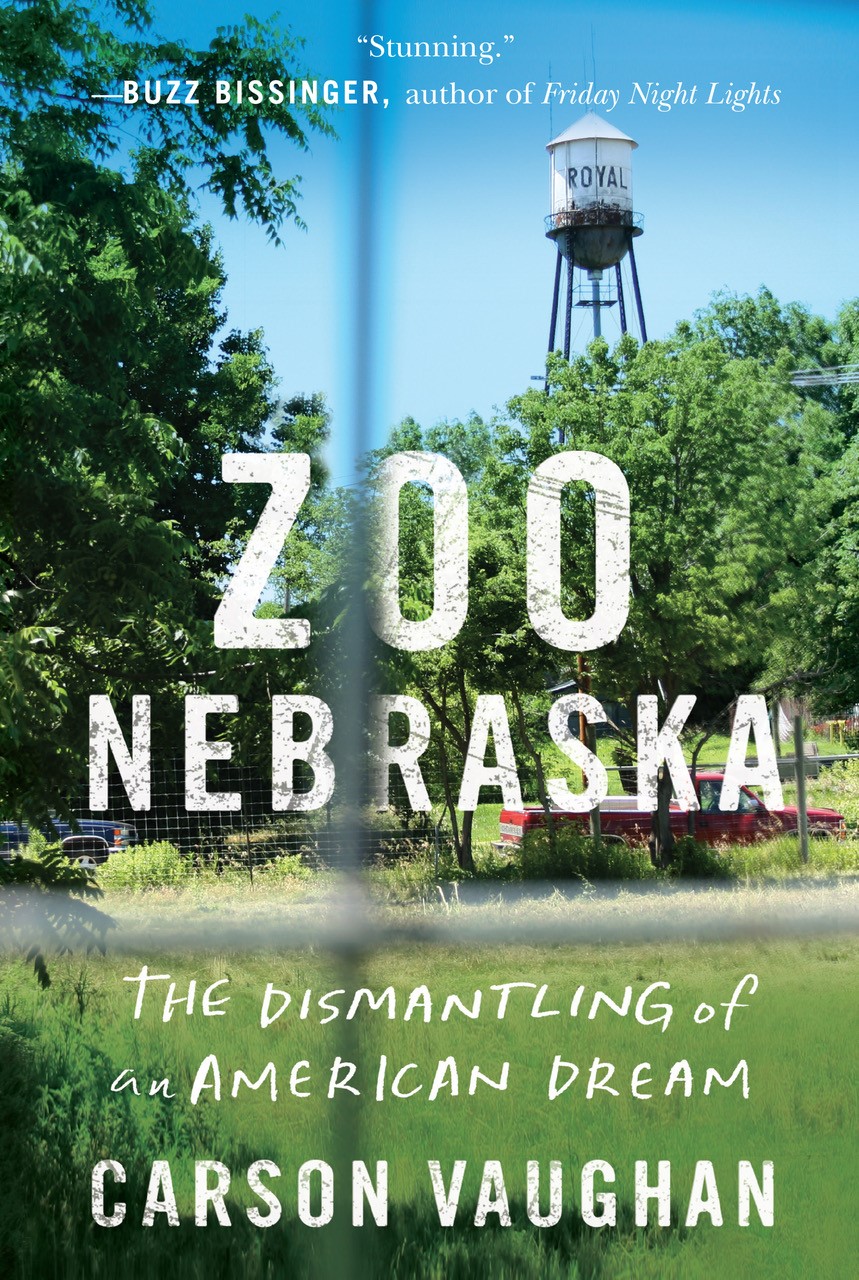 A few Nebraska natives still remember the little ragtag children’s zoo in Royal, Nebraska before its tragic end, but its existence has faded into the background of local knowledge like an empty, weathered barn. Easily overlooked. Carson Vaughan invites readers to slow down and take a closer look at what happened—or what could have, should have happened—in Zoo Nebraska: The Dismantling of an American Dream.
A few Nebraska natives still remember the little ragtag children’s zoo in Royal, Nebraska before its tragic end, but its existence has faded into the background of local knowledge like an empty, weathered barn. Easily overlooked. Carson Vaughan invites readers to slow down and take a closer look at what happened—or what could have, should have happened—in Zoo Nebraska: The Dismantling of an American Dream.
The murder of a mentor, a chimp named Reuben, a generous donation from Johnny Carson, and a white-knuckled hope to wring a scientific center out of an underfunded zoo drive founder and director Dick Haskin, but the dream alone can’t sustain him for long. Exhausted, Haskin turns directorship over to others, and we watch the actions of each new, well-meaning but misguided leader unravel into tragedy.
Vaughan calmly lays out the facts in vivid detail. Reading these pages I could feel the gravel crunch beneath my feet as he guided me through Royal, showing the empty buildings, the shadows of past residents. And I felt Vaughan’s shock as my own as he pointed, saying, “That’s where they shot Reuben.”
This week’s Friday Reads was guest written by Anna Weir, Publicist at the University of Nebraska Press! Vaughan will speak at the Nebraska Book Festival on September 7. Read Zoo Nebraska and bring your questions – I’m sure this candid narrator would be happy to answer.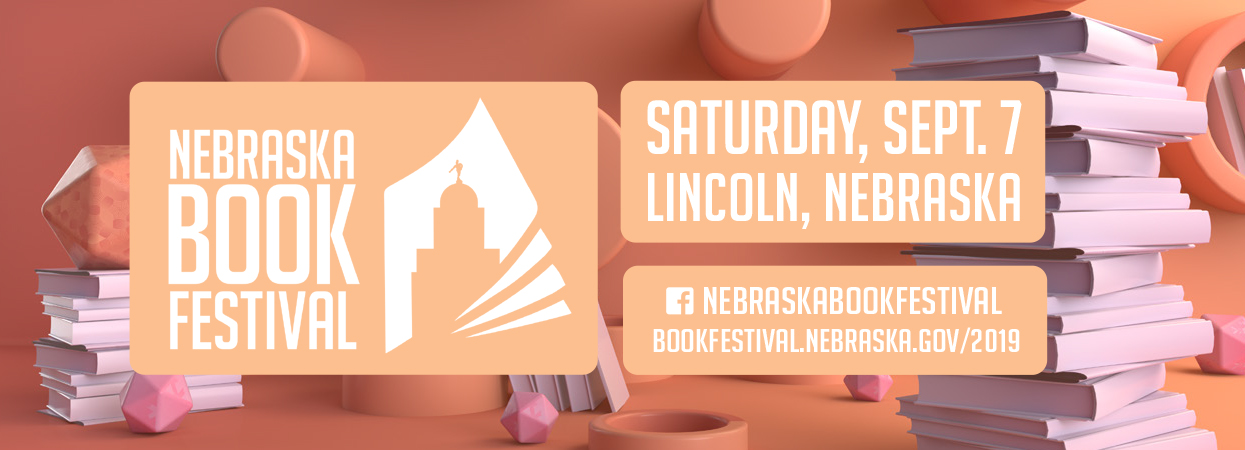
Vaughan, Carson. Zoo Nebraska: The Dismantling of an American Dream. Little A (2019)
#BookFaceFriday “Jigger Bunts”
This #BookFace was born a ramblin’ gamblin’ man.
Do you just love a good Western? If that’s the case this #BookFaceFriday is for you! “Jigger Bunts” by Max Brand (Blackstone Publishing, 2019) was recently discovered among his unpublished works and will delight fans of Max Brand Westerns. This is one of the 1,210 Westerns available to all Nebraska OverDrive Libraries! 173 libraries across the state share this collection of 12,407 audiobooks and 24,143 eBooks, with new titles added weekly. If you’re a part of it, let your users know about this great title, and if you’re not a member yet, find more information about participating in Nebraska Overdrive Libraries!
This week’s #BookFaceFriday model is Dave Eckmann, our Talking Book & Braille Service Circulation/Studio Support Clerk. Did you know Westerns are one of the most popular genres in our TBBS collection?
Love this #BookFace & reading? Check out our past #BookFaceFriday photos on the Nebraska Library Commission’s Facebook page!
Posted in Books & Reading, General
Tagged Book Art, Book Covers, bookface, bookfacefriday, books, OverDrive, Reading, Westerns
Leave a comment
Throwback Thusrday: On the Roundup
We’ve rounded up another #ThrowbackThursday for you!
This week’s photographic postcard was taken around 1913 and is provided by the Nebraska Library Commission.
See more Nebraska-related materials on the Nebraska Memories archive!
Nebraska Memories is a cooperative project to digitize Nebraska-related historical and cultural heritage materials and make them available to researchers of all ages via the Internet. The Nebraska Memories archive is brought to you by the Nebraska Library Commission. If your institution is interested in participating in Nebraska Memories, see http://nlc.nebraska.gov/nebraskamemories/participation.aspx for more information.
Posted in General, Nebraska Memories
Tagged #TBT, #ThrowbackThursday, cattle herding, cowboys, horses, Nebraska, Nebraska History, Nebraska Memories, postcards, roundup, Throwback Thursday
Leave a comment
Support local bookstores in August with the 2019 Bookwalk, a Nebraska Book Festival event
FOR IMMEDIATE RELEASE:
July 31, 2019
CONTACT:
Rosemary Sekora
Book Festival Coordinator
Publicity Manager
University of Nebraska Press
rsekora@unl.edu / 402.472.7710
Support local bookstores in August with the 2019 Bookwalk, a Nebraska Book Festival event
Lincoln, NE – Beginning August 1, support your local Lincoln bookstores with the Bookwalk!
Throughout the month of August visit participating bookstores, receive a specialty bookmark, and get your bookmark hole-punched when you visit the Lincoln bookstores. Then take your completed bookmark to Zipline Brewery on Sept. 6 to receive happy hour pricing.
At 7:00 p.m. on Friday, Sept. 6 at Zipline Brewery the book festival will host a literary quiz to Bookwalkers. Entry and participation is free!
A list of participating bookstores is below. Please see the Facebook event for more information or the Nebraska Book Festival website. The inaugural 2019 Bookwalk is sponsored by the Nebraska Book Festival.
Badgers Bookstore
4730 Cooper Ave, Lincoln, NE 68506
Bluestem Books
137 S 9th St, Lincoln, NE 68508
UNL Campus Store
1500 S St, Lincoln, NE 68508
Francie & Finch Bookshop
130 S 13th St, Lincoln, NE 68508
Indigo Bridge Books
701 P St #102, Lincoln, NE 68508
A Novel Idea Bookstore
118 N 14th St, Lincoln, NE 68508
Trade-A-Tape Comic Center
145 S 9th St, Lincoln, NE 68508
University of Nebraska Press Pop-Up Bookstores
8/3/19 – 11:00AM-2:00PM – White Elm Brewing Co. (720 Van Dorn St.)
8/28/19 – 10:00AM-2:00PM – The Mill Coffee & Bistro at Nebraska Innovation Campus
Zipline Brewing Co. PUB. Library
2100 Magnum Cir #1, Lincoln, NE 68522
###
The Nebraska Book Festival, taking place on Sept. 7 in UNL’s city campus union, is held to celebrate Nebraska’s literary heritage and contemporary authors and to stimulate public interest in books, reading, and the written word. By gathering together contemporary writing talent of our state and surrounding areas, the festival provides an opportunity for participants to cultivate an understanding of our history, culture and community. Support for the Nebraska Book Festival comes from Nebraska Center for the Book, Nebraska Library Commission, University of Nebraska Press, Lincoln City Libraries, Friends of the University of Nebraska Press, and Union Bank.
Friday Reads: Dog Man: Unleashed
 In keeping with the tradition of, er, I mean, my tradition of, lowbrow reading, this week’s installment is a little write up about Dog Man Unleashed. While the intended audience here is definitely grades 2+, uncultured readers of any age will enjoy the originality of this story. Dog Man Unleashed is the second installment in Dav Pilkey’s Dog Man series. The Dog Man series tells the post-accident stories of Dog Man (of course), a surgical union of a police officer and his sidekick police dog, Greg. An explosion resulted in injuries to both, so to save them, a surgeon sewed Greg’s dog head onto the human police officer’s body, resulting in (you guessed it), Dog Man.
In keeping with the tradition of, er, I mean, my tradition of, lowbrow reading, this week’s installment is a little write up about Dog Man Unleashed. While the intended audience here is definitely grades 2+, uncultured readers of any age will enjoy the originality of this story. Dog Man Unleashed is the second installment in Dav Pilkey’s Dog Man series. The Dog Man series tells the post-accident stories of Dog Man (of course), a surgical union of a police officer and his sidekick police dog, Greg. An explosion resulted in injuries to both, so to save them, a surgeon sewed Greg’s dog head onto the human police officer’s body, resulting in (you guessed it), Dog Man.
The writing appeals to younger reluctant readers and often isn’t grammatically correct (e.g. Super is “Supra”, and Laughs are “Laffs”), but who cares? You aren’t reading this for the highbrow storyline, you read it for the cartoonish illustrations and over the top tangents. And let’s face it, some educators need to lighten up a little bit and not worry about all these details. The antagonist Petey the cat (not to be confused with Pete the Cat), is the recurring up to no good villain who also appears in a couple of the Captain Underpants books, and has multiple schemes throughout the Dog Man Series. This installment (Dog Man Unleashed), while simplistic (Dog Man working to save the city from the evil, up to no good Petey), is effective in that it ultimately demonstrates kindness, empathy, friendship, teamwork, etc. However, the side stories, such as Dog Man tracking things with his smell, chasing cars, and hiding bones are equally entertaining. That and the simplistic illustrations will surely give the reader some welcome laffs.
One final note on those that express displeasure with the grammatical incorrectness of this book. Let me say that we often are caught up in rigidity at the expense of art and creativity. And (yep, I’m starting a sentence with And), that is evidence of one’s missing out on truly imaginative and unique things.
Pilkey, Dav. Dog Man Unleashed. Graphix (2016).
#BookFaceFriday “A Sister’s Memories”
#BookFaceFriday just loves a book with ties to the Good Life.
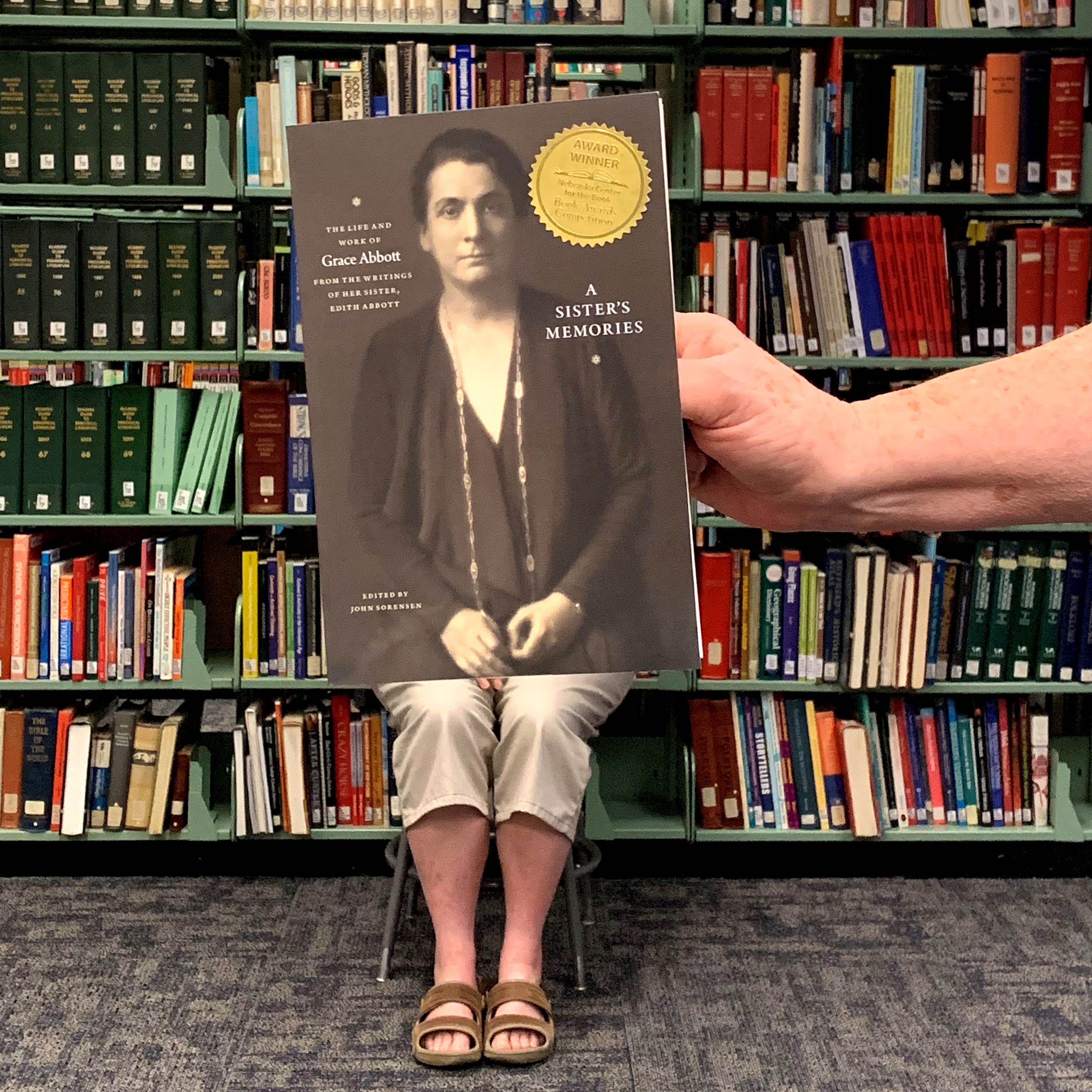
If you’re in the mood for a fascinating non-fiction read check out the Nebraska Book Award-winning historical biography “A Sister’s Memories: The Life and Work of Grace Abbott from the Writings of Her Sister, Edith Abbott” edited by John Sorensen (University of Chicago Press, 2015).
“Grace Abbott emerged as one of the leading reformers of her generation. Studious, committed, and experienced, she worked with recent immigrants through Hull House in Chicago, headed the Children’s Bureau, and assisted in the crafting of New Deal legislation. This lightly edited volume, compiled from the notes and partially written chapters of her sister Edith, provides some insights about the motivation and dedication with which she undertook this work. Edith Abbott was an accomplished social welfare worker in her own right, and intended to publish a book to ensure that her sister’s contributions would be remembered. She included personal anecdotes about their childhood in Nebraska, their years spent in Chicago, and correspondence from Grace’s long service with the Children’s Bureau. . . . Recommended.”(Choice)
This week’s #BookFace model is NLC’s Coordinator of Children and Young Adult Library Services, Sally Snyder!
Love this #BookFace & reading? We suggest checking out all the titles available for book clubs at http://nlc.nebraska.gov/ref/bookclub. Check out our past #BookFaceFriday photos on the Nebraska Library Commission’s Facebook page!
What’s Sally Reading?

How to Pronounce an Author’s Name
It has been awhile since I mentioned the place to go to learn how to pronounce an author’s name, on Teachingbooks.net – this section of the page is free to visit and use, you do not need to sign up for it.
The website on June 4, 2010 noted it had 2,207 author names included and on July 25, 2019, it had 2,559 author names included, so they are continuing to add pronunciations. For each entry the author has been recorded pronouncing his or her name, and they usually have a comment or two as well, about their families or a funny occurrence at a conference.
You may wonder why some of the authors’ names are included – they may pronounce their name just like we think it is, or it may be a bit different. For example, I listened to Gail Carson Levine since I wondered if she pronounces it Le-veen or Le-vine. It is Le-veen.
Many authors or illustrators give the listener a rhyming word to help remember the pronunciation. I liked Ibi Zoboi’s recording, explaining that her students used to say “Ibi is a boy” (even though she isn’t). Warning: you can spend a lot of time on this website.
 Mangoes, Mischief, and Tales of Friendship: Stories from India by Chitra Soundar contains two books from India of traditional folktales brought together in this volume encompassing a total of eight wisdom stories.
Mangoes, Mischief, and Tales of Friendship: Stories from India by Chitra Soundar contains two books from India of traditional folktales brought together in this volume encompassing a total of eight wisdom stories.
In them, Prince Veera and Suku, his best friend, occasionally step in for the King to listen to complaints and disagreements among their subjects. Some of the stories may be familiar to adults, but will intrigue those new to the logic used by the Prince. For example, one merchant charged a poor man for enjoying the aroma of his delicious baked goods. In another, a man sells his neighbor a well, but did not include the water.
Compassion and empathy are emphasized, and some humor is included as well. Stylized black-and-gray illustrations throughout add to the stories and there are only seven two-page spreads without any art. This title is designed for grades 3-6. (This will be on my Summer Reading Program list for 2020!)
(The Nebraska Library Commission receives free copies of children’s and young adult books for review from a number of publishers. After review, the books are distributed free, via the Regional Library Systems, to Nebraska school and public libraries.)
Posted in Books & Reading, General, Youth Services
Leave a comment
Throwback Thursday: Stinard Falls
Happy #ThrowbackThursday from Nebraska Memories!
 This week we have a 14 x 9 cm color postcard of Stinard Falls near Valentine, Nebraska.
This week we have a 14 x 9 cm color postcard of Stinard Falls near Valentine, Nebraska.
This photo is provided by Omaha Public Library. The items from Omaha Public Library in Nebraska Memories include early Omaha-related maps dating back from 1825 to 1922, as well as over 1,100 postcards and photographs in the Omaha area. The Omaha Postcard Collections show scenes of Omaha, spanning a time period from the 1890s to the 1920s.
Nebraska Memories is a cooperative project to digitize Nebraska-related historical and cultural heritage materials and make them available to researchers of all ages via the Internet. The Nebraska Memories archive is brought to you by the Nebraska Library Commission. If your institution is interested in participating in Nebraska Memories, see http://nlc.nebraska.gov/nebraskamemories/participation.aspx for more information.
Throwback Thursday
It’s off to the races with this week’s #ThrowbackThursday!
This 3″ x 5″ acetate negative photograph is owned by the Thorpe Opera House Foundation. It is part of the Boston Studio Project collection.
Want to see more of Nebraska’s history? Check out the Nebraska Memories archive!
Nebraska Memories is a cooperative project to digitize Nebraska-related historical and cultural heritage materials and make them available to researchers of all ages via the Internet. The Nebraska Memories archive is brought to you by the Nebraska Library Commission. If your institution is interested in participating in Nebraska Memories, see http://nlc.nebraska.gov/nebraskamemories/participation.aspx for more information.
#BookFaceFriday “Under the Harrow”
New Books = New #BookFaceFridays!
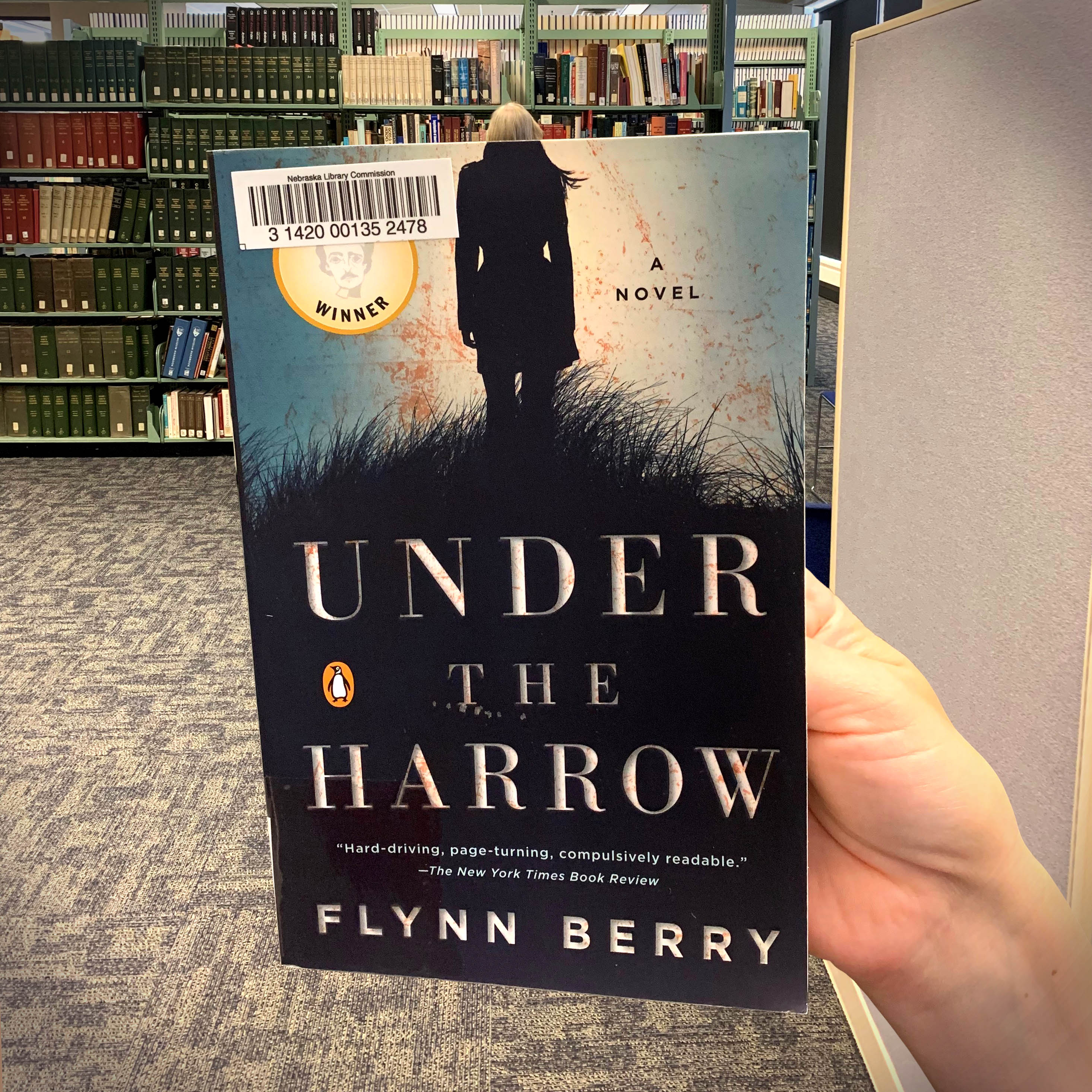 Has your book club been on the hunt for new reads? The NLC Book Club Kit collection is here to help! We’ve recently added several new titles to the collection, one of which is “Under the Harrow” by Flynn Berry (Penguin Books, 2016). For those of you who devoured “Gone Girl” and “Girl on a Train,” this psychological thriller is sure to get your blood pumping. Browse all the new additions at nlc.nebraska.gov/ref/bookclub today!
Has your book club been on the hunt for new reads? The NLC Book Club Kit collection is here to help! We’ve recently added several new titles to the collection, one of which is “Under the Harrow” by Flynn Berry (Penguin Books, 2016). For those of you who devoured “Gone Girl” and “Girl on a Train,” this psychological thriller is sure to get your blood pumping. Browse all the new additions at nlc.nebraska.gov/ref/bookclub today!
This week’s #BookFace photo is Cathy Hatterman, our Acquisitions Librarian! We added a large number of titles to our book club kit collection in the past 2 months! Cathy has been hard at work tracking down all our requests, as well as adding quite a few books to our library science collection.
Love this #BookFace & reading? Check out our past #BookFaceFriday photos on the Nebraska Library Commission’s Facebook page!
Posted in Books & Reading, General
Tagged Book Club, Book Club Kits, Book Covers, bookface, bookfacefriday, books, Flynn Berry, Under the Harrow
Leave a comment

